First Impressions: Microsoft's Windows 10 Event
Microsoft had its big Windows 10 Event in New York City on Wednesday, with several major product launches and unveilings. From watching the livestream and tracking coverage from RCP Editor at Large Jeff Schwartz who was on site, here are the big takeaways, especially for Microsoft partners.
This Was a 'Consumer' Day
Most, though not all, of Microsoft's announcements on Wednesday were aimed at consumers, in the sense of home users and gamers. Much of it also applied to students and educators, but the main overlap for business customers is in any department that employs creative professionals, who did have plenty to chew on. If some of the new products take off, they could give Microsoft a way to claw its way into the creative professional space that Apple has used as its beachhead into the business market. But for those looking for deployment advancements, system management, security improvements, et cetera, this wasn't your day.
Next on the Windows Roadmap: Windows 10 Creators Update
The word of the day was "creators," and it featured most prominently in the next version of Windows, which will ship in spring 2017 and be called Windows 10 Creators Update. In accordance with the Windows 10 business model, the update will be free for current users of Windows 10. Among the new features will be widespread support of 3-D technology within a new version of Paint (Paint 3D) and the Microsoft Edge browser. Demos included people quickly making holograms, and videos showed users sending creations off to 3-D printers.
Terry Myerson, executive vice president of the Windows and Devices Group at Microsoft, declared a wildly ambitious goal for the new version. He said that with the Creators Update, Microsoft wants to have the effect of the Gutenberg Press on the computing industry.
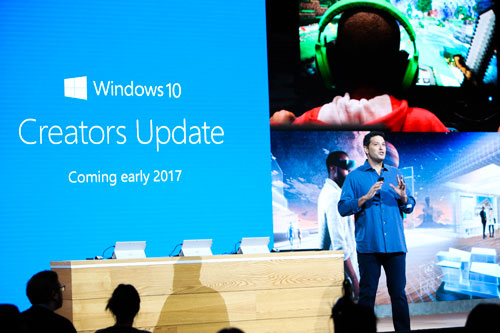 Microsoft Executive Vice President Terry Myerson announces the Windows 10 Creators Update.
Microsoft Executive Vice President Terry Myerson announces the Windows 10 Creators Update.
Big Hardware Reveal: Surface Studio
The major product launch Wednesday was the Surface Studio, which Microsoft Surface chief Panos Panay declared is the next category-creating device out of his team. Similar to an all-in-one PC (especially similar to Apple's all-in-one iMac), the Studio distinguishes itself with a huge 28-inch, yet very thin, touchscreen and two chrome arms that allow it to be folded down to a low angle for drawing. High-powered with 192 DPI resolution, the Studio will start at $2,999. According to the Microsoft Store, the Studio will start shipping in mid-December. Panay said it would be available in limited quantities for the holidays.
 Surface Studio
Surface Studio
Little Hardware Reveal: Surface Dial
A new device that goes with the Surface Studio but can also be used in a limited way with the Surface Book and the Surface Pro is the Surface Dial. The $100 device is shaped like a short cylinder, similar in size to an Amazon Echo Dot. The Dial represents a new method of user input in addition to the mouse, pen, touch, keyboard and voice. For the Studio, the Dial can be placed directly on the screen to light up new interface options (see the image below). For other Surface hardware, the Dial stays on the desk for scrolling, zooming and navigating.
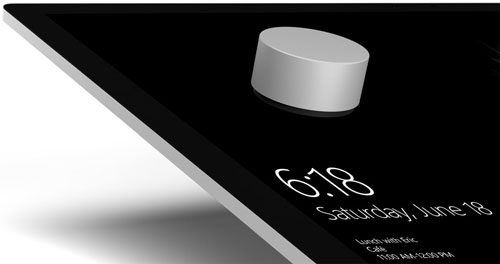 Surface Dial
Surface Dial
MIA #1: Surface Phone
There has been a lot of speculation that Microsoft might be on the cusp of releasing a Surface Phone that was somewhere on the phablet spectrum between a little tablet and a big phone. The new Windows 10 Mobile phone from HP, the HP Elite x3, made an appearance, but there were no signs or hints of a Surface Phone on Wednesday.
MIA #2: Surface Pro
A likely candidate for an update was the successful Surface Pro, but Microsoft chose not to refresh it ahead of the holiday season. Surface Pro 4 remains the top of the line.
Surface Book Gets Some Attention
Surface Book did get an update in New York, although not a fully numbered release (as in becoming the Surface Book 2). Microsoft's laptop with the removable and reversible screen got a new base and new processors. The three new models are branded Surface Book with Performance Base, and major feature improvements include i7 processors, a doubling of graphical processing power and a claimed 16-hour battery life. The Performance Base models start at $2,399 and will begin shipping Nov. 10.
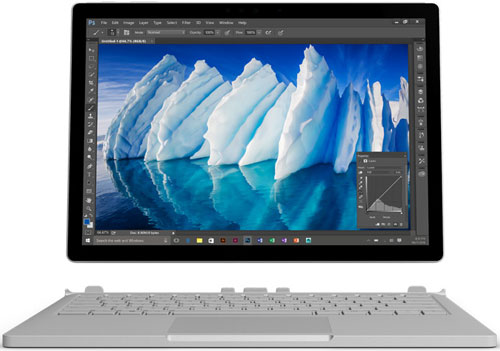 Surface Book with Performance Base
Surface Book with Performance Base
Showing Off with PowerPoint
Microsoft plans to integrate 3-D technologies into many of its apps over the next year. To show what's coming, Microsoft did a demo on Wednesday with PowerPoint. The process of dragging in 3-D objects and building in animated motion of the objects appeared to be simple and quick. In automated slideshow mode, the presentation looked more like a graphical short film than a traditional slide deck.
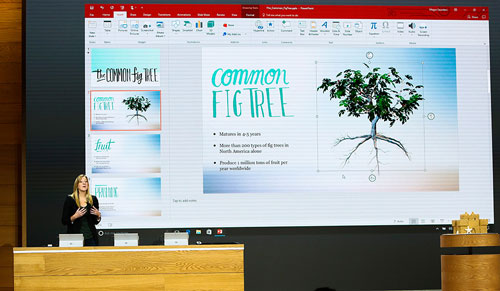 Microsoft's Heather Alekson demonstrates Windows 10's 3-D capabilities using a PowerPoint presentation as an example.
Microsoft's Heather Alekson demonstrates Windows 10's 3-D capabilities using a PowerPoint presentation as an example.
From Smartphone Camera to 3-D Model
Microsoft General Manager Megan Sanders gave one of the best demos of the day when she used the camera of an HP Elite x3 smartphone running Windows 10 Mobile to create a 3-D model of a real-world object. Walking slowly around a sand castle, Sanders captured a 3-D image that she was then able to manipulate and combine with other elements from within Paint 3D. While the demo involved a phone using Windows 10 Mobile, Sanders said of the Windows Capture 3D Experience: "We envision this experience on any device."
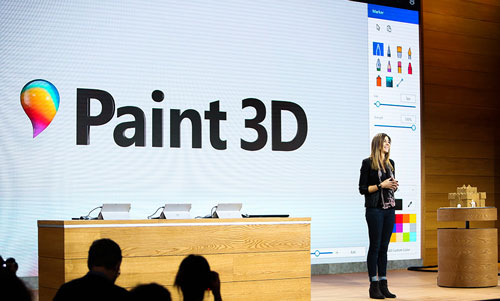 Microsoft's Megan Sanders demos Paint 3D.
Microsoft's Megan Sanders demos Paint 3D.
OEMs Getting into Microsoft's Mixed Reality Game
When it comes to the augmented-reality/mixed-reality experiences that Microsoft wants developers to create and users to enjoy, the Microsoft HoloLens won't be the only option for viewing them. Microsoft on Wednesday announced that HP, Lenovo, ASUS, Dell and Acer will ship mixed-reality-capable headsets for use with the Creators Update in 2017. Myerson said the accessories would start at $299.
Posted by Scott Bekker on October 26, 2016